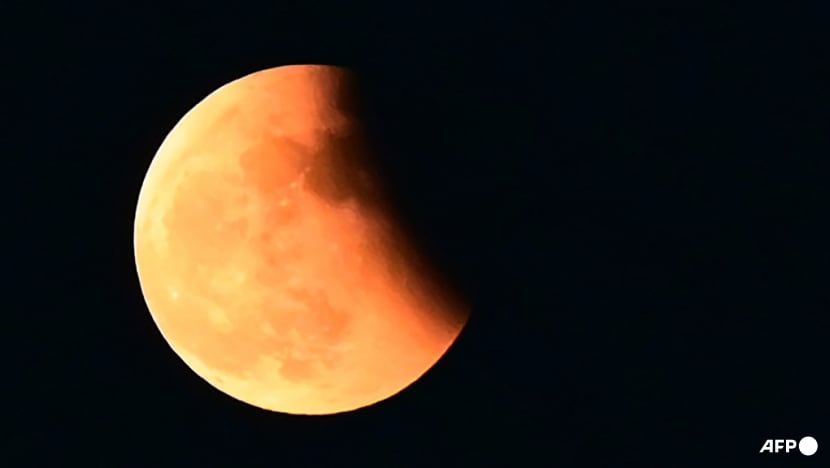'Blood Moon' total lunar eclipse to happen over Singapore's sky on Sep 7
The last time a total lunar eclipse was visible in Singapore was in November 2022.

A "Blood Moon" is seen during a total lunar eclipse in Prayagraj, India on Nov 8, 2022. (Photo: AFP/Sanjay Kanojia)

This audio is generated by an AI tool.
SINGAPORE: Astrophotography enthusiasts and skywatchers are getting ready for an astronomical event happening next month, as Singapore is set to witness a total lunar eclipse for the first time in almost three years.
A "Blood Moon" total lunar eclipse is expected to occur on Sep 7.
It will begin at 11.28pm and stretch to 4.55am on Sep 8, with the "Blood Moon" occurring from 1.30am to 2.52am, The Observatory at Science Centre Singapore said on Monday (Aug 25).
The phenomenon, which will happen when the Moon is high overhead, can be viewed almost anywhere over the island if the sky is clear.
No special equipment is needed to view the total lunar eclipse because it will be visible to the naked eye, the observatory added.
However, observers should note that weather conditions and frequent cloud cover in Singapore could affect visibility, and the observatory advised those intending to catch the eclipse to check the weather forecast.
The event will be visible primarily across Africa, Asia, Australia and Europe, the National Geographic website reported.
The last total lunar eclipse visible in Singapore was on Nov 8, 2022. A similar eclipse occurred on Mar 14 this year but was not visible due to the country's geographical position.
The next one visible here will be in March 2026, based on data from the Time and Date website.
WHAT HAPPENS DURING A TOTAL LUNAR ECLIPSE
A total lunar eclipse happens when the Moon plunges fully into the darkest core of the Earth's shadow and undergoes a gradual yet dramatic transformation, the observatory said.
"As the Earth moves directly between the Sun and the Moon during the full moon phase, its shadow will steadily cover the lunar surface.
"Over the course of several hours, the Moon's brightness will dim before taking on a rich, reddish hue, a result of sunlight filtering through Earth's atmosphere and scattering shorter wavelengths of light (such as blues and greens)."
The Moon then takes on a red or orange glow as the longer wavelengths and warmer tones slip through, the observatory said.
Lunar eclipses occur about one to four times a year.
Other types of eclipses include partial and penumbral ones.
These eclipses "are occasional delights rather than a monthly occurrence" because the Moon's orbit is tilted in relation to Earth's path around the Sun, the observatory added.
If you would like to send in information, photos or videos about something newsworthy, submit your news tips on CNA Eyewitness or on WhatsApp.















